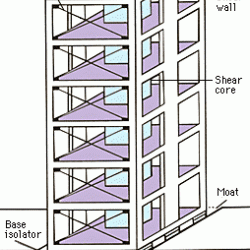Source Institutions
Source Institutions
Add to list Go to activity
Activity link broken? See if it's at the internet archive

In this geology and engineering activity (page 7 of the PDF), learners build an earthquake simulator, then use it to test various building designs, exploring different materials, shapes, and design options that affect the durability of structures. Although this was created as a post-visit activity for a workshop about earth processes, it also makes an excellent stand-alone activity.
- 45 to 60 minutes
- 1 to 2 hours
- Over $20 per group of students
- Ages 14 - 18
- Activity, Experiment/Lab Activity
- English
Quick Guide
Materials List (per group of students)
- Computers with Internet access (optional but very helpful)
- A 1-inch × 10-foot piece of #40 PVC plastic pipe, which will be cut into two 24-inch pipes and two 30-inch pipes
- Four 1-inch #40 PVC 90 degree elbows
- Two ½ inch x 36 inch dowels wooden dowels
- One piece of plywood .25 × 24 × 24 inches
- Four eyebolts, .25 × 2.5 inches with .25 inch nuts
- Four hex bolts, .25 × 1 inch, with .25 inch nuts
- Four rubber bands, #64
- One saw
- One drill with .25-inch drill bit
- Hot glue
- Styrofoam packing blocks
- Wood blocks
- Spongy foam
- Cardboard
- Scissors (for cutting the foam board or cardboard)
- Shallow box or pan
- Marbles
- Wood dowels or pencils
- Large sponge
- Sand (optional)
- Teflon cooking sheets (optional)
- Pencil
- Paper
Subjects
-
Earth and Space Science
-
Earth Processes
- Earthquakes
-
Earth Processes
-
Engineering and Technology
-
Engineering
- Architectural Engineering
-
Engineering
-
Physical Sciences
- Motion and Forces
-
The Nature of Technology
-
The Design Process
- Invention and Innovation
- Problem Solving
- Troubleshooting and Maintenance
-
The Design Process
Audience
To use this activity, learners need to:
- see
- touch
Learning styles supported:
- Involves teamwork and communication skills
- Uses STEM to solve real-world problems
- Involves hands-on or lab activities
Other
Includes alignment to state and/or national standards:
This resource is part of:
Access Rights:
- Free access
By:
Source Collection
- Student Workshops
Rights:
- All rights reserved, COSI Columbus, 2009
